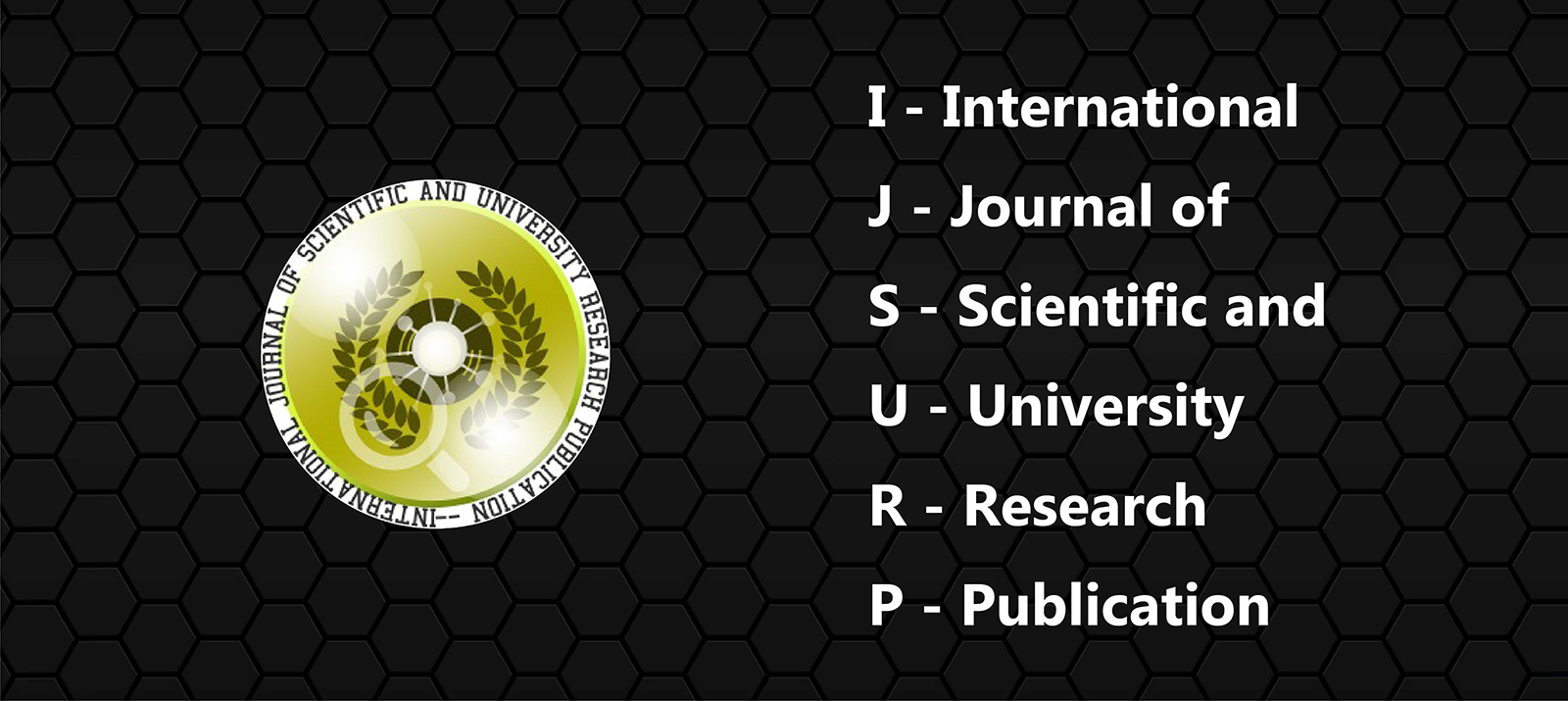
Antagonistic Potentiality of Fungal Pathogens Against Trichoderma Viride And Trichoderma Harzianum
Authore(s) : KARTHIKEYAN P || Department of MicrobiologySt. Joseph University College of Agricultural Science and TechnologySongeaTanzania.
Volume : (3), Issue : 211, January - 2019
Abstract : In the present study, five plant pathogens obtained from St. Joseph University College of Agricultural Science and Technology, Songea, Tanzania. The biocontrol agents were tested against active plant pathogenic fungi. Bio control agents namely T. viride and T. harzianum and plant pathogens namely Aspergillus niger, A. fumigatus, A. luchensis, Humicola and Bipolaris oryzae were tested. T. viride and T. harzianum were effective bio control agents against all tested plant pathogens. Trichoderma viride had good antagonistic active against all pathogenic fungi. T. viride showed maximum percentage inhibition activity against Humicola sp.(82.8%).
Keywords :Antagonistic activity, Trichoderma viride, Trichoderma harzianum
Article: Download PDF Journal DOI : 2364/2018
Cite This Article:
Antagonistic activity, Tricho- derma viride, Trichoderma harzianum
Vol.I (3), Issue.I 211
Article No : 10007
Number of Downloads : 102
References :
Ambikapathy,V., panneerselvam,A., saravanamuthu,R., 2002. Antagonistic effect of soil fungi to Fusariumsolaniappel and wllenweher Agrisci digest 22(1):14-17.
Barak, R. and Chet, I. 1986. Determination, by fl uorescein diacetate staining, of fungal viability during mycoparasitism. Soil Biol. Biochem., 18:315–9.
Boehm, M.J., Hoitink, H.A., 1999. Biocontrol within the context of soil microbial communities: A substrate – dependent... More
- Ambikapathy,V., panneerselvam,A., saravanamuthu,R., 2002. Antagonistic effect of soil fungi to Fusariumsolaniappel and wllenweher Agrisci digest 22(1):14-17.
- Barak, R. and Chet, I. 1986. Determination, by fl uorescein diacetate staining, of fungal viability during mycoparasitism. Soil Biol. Biochem., 18:315–9.
- Boehm, M.J., Hoitink, H.A., 1999. Biocontrol within the context of soil microbial communities: A substrate – dependent phenomenon. Annu. Rev. Phytopathol.37: 427-446.
- Chet, I. 1987. Trichoderma-Application, mode of action, and potential as a bio- control agent of soilborne pathogenic fungi. Innovative Approaches to Plant Disease Control. New York: Wiley and Sons, 137–60.
- Fokkema, N.J. 1978. Fungal antagonism in the phylophere. Ann. Appl. Biol. 89,115-117.
- Fravel,D.,2005.Commercialization and implementation of biocontrol. Ann.Rev.Phytopathol, 43:337-359.
- Ghisalberti, E.L., Narbey, M.J., Dewan, M.M., Sivaithampatam, K., 1990.Properties and biocontrol activity of aerial submerged spores in Trichoderma asperellum. Plant and Soil. 121: 287-291.
- Govindasamy, V. and Balasubramanian, 1989.Properties and biocontrol activity of aerial and submerged spores in Trichoderma asperellum. J. Plant Dis. Prot. 96:337-345.
- Harman, G.E. and Bjorkman, T. 1987. Potential and existing uses of. Trichoderma and Gliocladium for, plant disease control and plant growth enhancement. In Harman G.E., Kubicek C.P., ed. Trichoderma and Gliocladium. Vol. 2. London: Taylor and Francis, 229–65.
- Hjelijord, L.G. and Tronsmo, A., 2003. Properties and biocontrol activities of aerial and submerged spores in Trichoderma.asperellum.Phytopathology. 93:1593-1598.
- Howell, C.R. 2003. Mechanisms employed by Trichoderma species in the bio- logical control of plant diseases: The history and evolution of current concepts. Plant Disease, 87(1):4–10.
- Jayarajan, R. and Nakkeeran, S. 2000.Exploitation of microorganisms and viruses as biocontrol agents for crop disease management .Crop Dis.Weeds and Nemat.1:95-116.
- Kovach, J., Petzoldt, R. and Harman, G.E., 2000. properities and biocontrol ac- tivities of aerial and submerged spores in Trichoderma asperellum. Biol. Control.18: 235-242.
- Papavizas, G.C.1985. Trichoderma and Gliocladium: Biology, ecology and poten- tial for biocontrol. Ann. Rev. Phytopathol. 23:23-54.
- Watanabe, S., Kumakura, K., Kato, H., Lyozumi, H., Togawa, M. and Nagayama, K., 2005. Gen. Plant Pathol. 71: 351-356.
- Warcup, J.H., 1950. The soil plate method for isolation of fungi from soil. Nature, Lond, 178:1477.
- Yedidia, I., M. Shoresh, K. Kerem, N. Benhamou, Y. Kapulnik & I. Chet. 2003. on-comitantinduction of systemic resistance to Pseudomonas syringae pv. lachrymans in cucumber by Trichoderma asperellum (T-203) and the accumulation of phytoalexins. Appl. Environ. Microbiol, 69:7343-53.
... Less
- Ambikapathy,V., panneerselvam,A., saravanamuthu,R., 2002. Antagonistic effect of soil fungi to Fusariumsolaniappel and wllenweher Agrisci digest 22(1):14-17.
- Barak, R. and Chet, I. 1986. Determination, by fl uorescein diacetate staining, of fungal viability during mycoparasitism. Soil Biol. Biochem., 18:315–9.
- Boehm, M.J., Hoitink, H.A., 1999. Biocontrol within the context of soil microbial communities: A substrate – dependent phenomenon. Annu. Rev. Phytopathol.37: 427-446.
- Chet, I. 1987. Trichoderma-Application, mode of action, and potential as a bio- control agent of soilborne pathogenic fungi. Innovative Approaches to Plant Disease Control. New York: Wiley and Sons, 137–60.
- Fokkema, N.J. 1978. Fungal antagonism in the phylophere. Ann. Appl. Biol. 89,115-117.
- Fravel,D.,2005.Commercialization and implementation of biocontrol. Ann.Rev.Phytopathol, 43:337-359.
- Ghisalberti, E.L., Narbey, M.J., Dewan, M.M., Sivaithampatam, K., 1990.Properties and biocontrol activity of aerial submerged spores in Trichoderma asperellum. Plant and Soil. 121: 287-291.
- Govindasamy, V. and Balasubramanian, 1989.Properties and biocontrol activity of aerial and submerged spores in Trichoderma asperellum. J. Plant Dis. Prot. 96:337-345.
- Harman, G.E. and Bjorkman, T. 1987. Potential and existing uses of. Trichoderma and Gliocladium for, plant disease control and plant growth enhancement. In Harman G.E., Kubicek C.P., ed. Trichoderma and Gliocladium. Vol. 2. London: Taylor and Francis, 229–65.
- Hjelijord, L.G. and Tronsmo, A., 2003. Properties and biocontrol activities of aerial and submerged spores in Trichoderma.asperellum.Phytopathology. 93:1593-1598.
- Howell, C.R. 2003. Mechanisms employed by Trichoderma species in the bio- logical control of plant diseases: The history and evolution of current concepts. Plant Disease, 87(1):4–10.
- Jayarajan, R. and Nakkeeran, S. 2000.Exploitation of microorganisms and viruses as biocontrol agents for crop disease management .Crop Dis.Weeds and Nemat.1:95-116.
- Kovach, J., Petzoldt, R. and Harman, G.E., 2000. properities and biocontrol ac- tivities of aerial and submerged spores in Trichoderma asperellum. Biol. Control.18: 235-242.
- Papavizas, G.C.1985. Trichoderma and Gliocladium: Biology, ecology and poten- tial for biocontrol. Ann. Rev. Phytopathol. 23:23-54.
- Watanabe, S., Kumakura, K., Kato, H., Lyozumi, H., Togawa, M. and Nagayama, K., 2005. Gen. Plant Pathol. 71: 351-356.
- Warcup, J.H., 1950. The soil plate method for isolation of fungi from soil. Nature, Lond, 178:1477.
- Yedidia, I., M. Shoresh, K. Kerem, N. Benhamou, Y. Kapulnik & I. Chet. 2003. on-comitantinduction of systemic resistance to Pseudomonas syringae pv. lachrymans in cucumber by Trichoderma asperellum (T-203) and the accumulation of phytoalexins. Appl. Environ. Microbiol, 69:7343-53.






